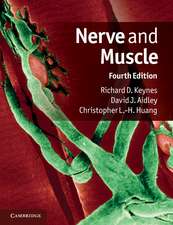Metals and Oxidative Damage in Neurological Disorders
Editat de James R. Connoren Limba Engleză Hardback – 29 sep 1997
| Toate formatele și edițiile | Preț | Express |
|---|---|---|
| Paperback (1) | 1221.69 lei 43-57 zile | |
| Springer Us – 3 iun 2013 | 1221.69 lei 43-57 zile | |
| Hardback (1) | 1227.99 lei 43-57 zile | |
| Springer Us – 29 sep 1997 | 1227.99 lei 43-57 zile |
Preț: 1227.99 lei
Preț vechi: 1497.54 lei
-18% Nou
Puncte Express: 1842
Preț estimativ în valută:
234.100€ • 243.86$ • 196.42£
234.100€ • 243.86$ • 196.42£
Carte tipărită la comandă
Livrare economică 17-31 martie
Preluare comenzi: 021 569.72.76
Specificații
ISBN-13: 9780306455346
ISBN-10: 030645534X
Pagini: 374
Ilustrații: XXII, 374 p.
Dimensiuni: 178 x 254 x 24 mm
Greutate: 0.74 kg
Ediția:1997
Editura: Springer Us
Colecția Springer
Locul publicării:New York, NY, United States
ISBN-10: 030645534X
Pagini: 374
Ilustrații: XXII, 374 p.
Dimensiuni: 178 x 254 x 24 mm
Greutate: 0.74 kg
Ediția:1997
Editura: Springer Us
Colecția Springer
Locul publicării:New York, NY, United States
Public țintă
ResearchDescriere
The purpose of this book is to bring together scientists and clinicians interested in oxidative injury in the nervous system but whose approaches to investigation and treatment design vary widely. Indeed the goal of this book is to show that the investiga tive approaches and potential therapeutic interventions perhaps do not vary as widely as some may think. I think that the readers of this book will not read it from front to back, but will pick chapters of interest. Thus, the chapters are organized to contain information that is essential to understanding basic aspects of oxidative injury, and thus have some redundancy. However, within the context of each chapter the reader should hopefully find impetus and direction to go on to another chapter. The book is divided into three seetions. The first section contains reviews of metals and their role in generating oxidative injury. lron is considered in three of these chapters because of its relative abundance in the brain and its potency in inducing free radicals. The second section focuses on mechanisms by which the brain attempts to protect itself from oxidative injury. Some of these mechanisms have the potential to be protective in some situations and potentiaIly damaging in others. The third section contains the clinicaI diseases in which oxidative injury is known to contribute to the pathogenic process. This seetion ends with a chapter on antioxidant therapeutic strate gies in neurological disorders.
Cuprins
Evidence for Iron Mismanagement in the Brain in Neurological Disorders; J.R. Connor. Iron and Neurotransmitter Function in the Brain; Y. Glinka, et al. Magnetic Resonance Imaging of Brain Iron; G. Bartzokis. Neurochemical Roles of Copper as Antioxidant or Prooxidant; J.R. Prohaska. Manganese Neurotoxicity and Oxidative Damage; M. Aschner. The Role of Zinc in Brain and Nerve Functions; A.S. Prasad. Delivery of Metals to Brain and the Role of the Blood-Brain Barrier; Q.R. Smith, et al. Ferritin: Intracellular Regulator of Metal Availability; J.G. Joshi. Ascorbate: An Antioxidant Neuroprotectant and Extracellular Neuromodulator; G.V. Rebec. Vitamin E: Neurochemical Aspects and Relevance to Nervous System Disorders; G.T. Vatassery. Nitric Oxide and Oxidative Damage in the CNS; D.A. Dawson. Iron and Oxidative Stress in Neonatal Hypoxic-Ischemic Brain Injury: Directions for Therapeutic Intervention; C. Palmer. The Role of Oxidative Processes and Metal Ions in Aging and Alzheimer's Disease; L.A. Shinobu, M.F. Beal. Perspectives on the Mechanisms of Familial Amyotrophic Lateral Sclerosis Caused by Mutations in Superoxide Dismutase; D.R. Borchelt, et al. 3 Additional Chapters. Appendix. Index.














